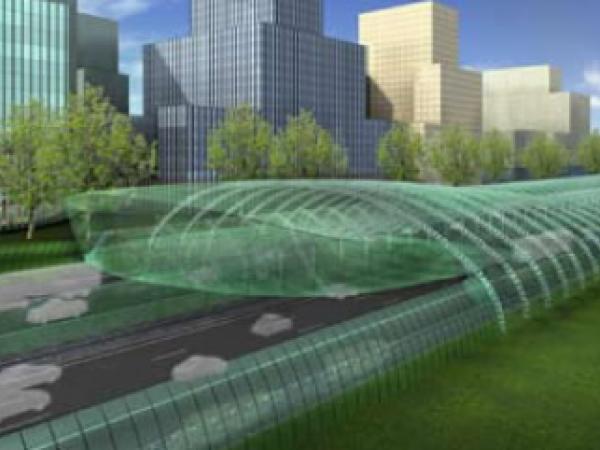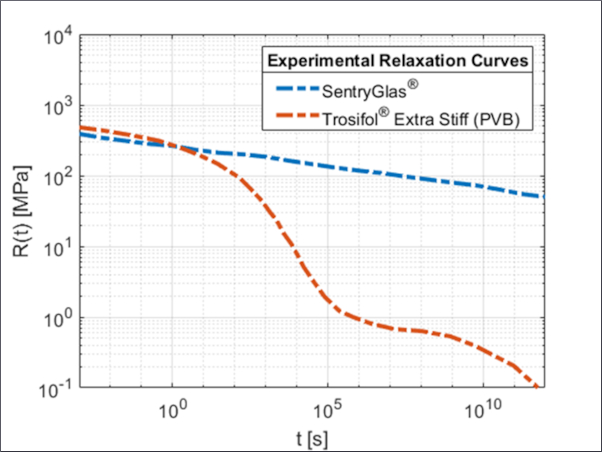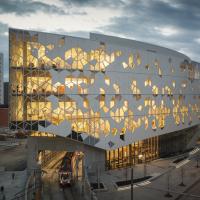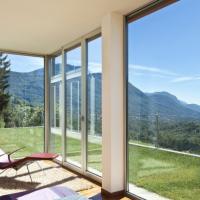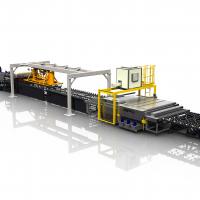Tighter legislation is making noise nuisance and air quality increasingly important when it comes to obtaining environmental permits for new or expanded infrastructure, especially in densely populated urban areas.
The ‘Sustainable Highway‘ concept offers an integrated solution to motorway emission and noise problems. It consists of a motorway canopy made of cold-bendable laminated glass. This transparent material is bendable on site at ambient temperature.
In panes of this glass the positive qualities of warm bent, laminated glass and of plastics are united. They are flexible as plastic and lightweight. Their optical quality is much better than the one of traditionally warm bent, laminated glass and their price is considerably lower, comparable with the one of synthetics.
It only pollutes slightly, does not scratch, it does not age and therefore requires little maintenance. Moreover, it is of value from the point of view of sustainable building.
Key factors here are durability, safety, cost and revenue. The design yields a significant reduction in noise, fine particulates, NOX, SOX and CO2.

Fig. 1: Motorway canopy, here merging into noise barrier
The air is cleansed of fine particulates using electrostatic filtering while the nitrogen oxide emitted by the vehicles is disposed of by adsorption. Furthermore, solar cells incorporated into the glass produce clean energy. The excess heat that accumulates in the summer is stored in the groundwater and used to heat the asphalt in the winter. This still leaves plenty of heat for such purposes as domestic heating.
The design therefore helps to reduce CO2 emissions. Furthermore, biofuel can be produced under the canopy, creating a conversion of carbon dioxide into oxygen. It also reduces the infrastructure footprint, freeing up building land in urban environments. The more even temperature, the reduced ultraviolet irradiation and the elimination of salt increase the life of the road surface, consequently reducing traffic jams due to maintenance.
The Sustainable Highway makes it possible to increase road capacity, boosts urban accessibility and supports government policy aimed at concentrating new build in urban environments, thus saving the green area.
It has been granted the "Nationale Geluid en Trillingen Innovatieprijs 2007" (National Noise and Vibrations Innovation Award 2007) and the "Nationale Innovatieprijs Luchtkwaliteit 2007" (National Innovation Award Air Quality 2007).
Introduction
Air pollution is high on the political agenda worldwide. Emissions have to be reduced. Tighter legislation is making noise nuisance and air duality increasingly important when it comes to obtaining environmental permits for new or expanded infrastructure.
Furthermore, highway managers have to deal with road wear and with pollution in the form of salt draining off into the soil.
The "Sustainable Highway" concept offers an integrated solution to these problems. It consists of a motorway canopy made of cold-bendable laminated glass (Fig. I). Key factors here are durability, safety, cost and revenue.
The design yields a significant reduction in noise, fine particulates, NOX, SOX and CO2, and also in the use of fossil fuels. It also reduces the infrastructure footprint, freeing up building land in urban environments. The Sustainable Highway makes it possible to increase road capacity, boosts urban accessibility and supports government policy aimed at concentrating new build in urban environments.
This innovative system is an entirely new way of using proven technologies. The design solves a number of current problems; it not only resolves the local problem of compliance with environmental regulations, but is also sustainable and saves energy. The technology used has all been thoroughly tested, making the design highly realistic.
All components have been used in applications of which the feasibility has already been proven. In comparison with other solutions to these problems, the Sustainable Highway is highly attractive in terms of structure, problem resolution and aesthetics. Furthermore, it is possible to make an accurate cost estimate.
The following sections will explain the essential elements of the concept.
Cold-bendable glass canopy
The canopy is made of cold-bendable laminated glass (Fig. 2). This material is visually attractive, safe, inexpensive and highly durable in comparison with other materials. The glass used is Freeformglass®, patented by Movares.‘
The results of tests (including tests conducted by TllO) and practical experience have shown this glass to be durable and vandalism-resistant. The innovative system used to fix the glass ensures that it remains in its frame for at least 30 minutes in case of a major fire (70 l/IW).
The example design consists of a canopy over a dual carriageway motorway, with each carriageway consisting of three lanes (Fig. 3). The structure is made up of arches, formed of castellated steel beams, supported on steel columns between the two carriageways.
Purlins and steel cross members between the arches (spaced 5.50 m o.c.) form a framework that supports the cold bendable laminated glass panels (3.10 m x 1.10 m), which form the skin of the canopy. The canopy is large enough to accommodate normal roadside structures comfortably.
Overall width is 50 m. The assumption is that each carriageway has its own canopy, with the two carriageways separated by a transparent wall. The sides of the canopy are also closed off by transparent walls. The advantage of a transparent canopy is that daylight can enter, making artificial light superfluous during the day.
This makes it easier to move around in the event of an emergency, and under normal circumstances improves road users’ orientation and overview. This is in marked contrast to the tunnels generally used to overcome the environmental disadvantages of motorways.
Furthermore, the transparent structure provides a clear view of the interior from the outside, making the job of the emergency services easier and above all safer.
Air pollution
The air quality problem next to the canopy is eliminated – no emissions.
But if no precautions are taken, the air will simply escape at each end. Exhaust gases will escape in concentrated form, continuing to generate excessively high pollutant levels along the road.
The longer the canopy, the more concentrated the emissions at each end. Depending on the length of the canopy, and the options for netting, the structure may or may not ensure compliance with air quality regulations.
The average background levels along many motorways in the Randstad (the urban conurbation in the west of the Netherlands) are so high that it would not be possible to simply allow exhaust gases to exit the canopy and still comply with Dutch emission limits.
Emissions have to be reduced substantially in order to meet these requirements at the ends of the canopy. This reduction is achieved by recirculating the air over the carriageways and by cleaning this circulating air.
Natural air currents are used to prevent excessive leakage of contaminated air at the canopy ends. Traffic movement sets up a flow of air under the canopy, and the airspeed and the cross section of the canopy mean that large amounts of air are set in motion. The principle consists of “short circuiting” the airflow that vehicle movement causes in each half of the covered road, by suitable design of the canopy entrances, creating a circuit (see Fig. 4 and Fig. 5).
Part of the air that leaves the tunnel from one carriageway is directed across to the opposite carriageway, where the movement of the vehicles draws it along in the opposite direction. This holds part of the air under the canopy in a circuit. Simulations indicate that 50% recirculation is completely feasible.
The recirculated air can be cleansed of fine particulates at the specially designed ends of the canopy, using ionization and electrostatic filtering just under the roof. Nitrogen and sulphur oxide emissions can be reduced by adsorption using active carbon. Again, this technique can be employed at the canopy portals (see Fig. 6) or elsewhere under the canopy.

Fig. 2: Structural principle of the motorway canopy

Fig. 3: Typical structure cross-section

Fig. 4: Air circulation induced by vehicles moving in oppo-site directions

Fig. 5: Removal of fine particu-lates from the air at thecanopy portal

Fig. 6: End of motorway canopy
New Products & Applications
A somewhat less environmentally friendly approach would be not to clean the air. The temperature rise under the canopy would expel the air to a high altitude via chimneys sited at the portals. Pollutants would be sufficiently diluted by the time they neared the ground.
It would also be possible to use both techniques, cleaning the air at the portals and diluting the pollutants by expelling the cleaned air using the chimney effect.
One great advantage of the air management methods described here is that only limited amounts of energy are needed to extract or displace the air, as use is made of natural air movement under the canopy. Artificial ventilation will only be required during traffic congestion, when vehicles remain stationary under the canopy.
Noise
The canopy blocks the emission of noise in all directions. As a result, it reduces noise nuisance around the motorway to an even greater extent than a noise barrier. Rising traffic levels are leading to ever higher noise barriers, which are considerably more expensive.
Sound pressure increases within the canopy, creating a reverberant field of a certain intensity. The degree to which sound pressure rises depends on how much sound is absorbed within the canopy.
The canopy is approximately 5 db(A) better at reducing noise than a noise barrier of maximum effectiveness, and 20 dB(A) better than a situation with little screening effect (see Fig. 7). Where the canopy is installed at particularly sensitive locations, the wall can be extended further than the roof, providing a degree of noise protection for less sensitive areas (see Fig. 1).
Biofuel production
To make future expansion of the road possible and to assure a sustainable solution in that way, the canopy can be built one or two lanes wider than necessary. This gives the opportunity to grow crops outside the crash barriers for the production of biofuel, until the road will actually be broadened (see Fig. 8). These plants take advantage of the heat accumulated under the canopy forming a greenhouse and convert carbon dioxide into oxygen. They can be irrigated with the rainwater caught by the canopy.
Energy production
As well as reducing pollution from motorways, the Sustainable Highway addresses climate issues. The heat that accumulates under the canopy can be stored and used to heat nearby houses in winter. It is also possible to incorporate solar cells into the cold bendable glass to generate electricity.
By laying tubes in the road and using the groundwater as a storage medium, it is possible to cool the road surface in the summer and heat it in the winter. Because this system is used in combination with the canopy, it is
possible to store in the groundwater the large amounts of excess heat that accumulate under the canopy during the summer due to solar radiation and heat emission from the vehicles passing through. In the winter, the warm groundwater can be pumped through the road structure via heat exchangers, warming the road (see Fig. 9).
The road surface therefore maintains a more constant temperature between summer and winter, which increases its service life. This reduces disruption due to maintenance, and hence reduces accidents. A further advantage is that there is no need to apply salt in winter.
The large quantity of surplus heat that accumulates makes it essential to utilize the stored energy. This energy has a range of possible uses, including the heating of nearby homes. One kilometre of motorway with a canopy of the type described here will generate enough energy to heat 2,400 homes, with marginal running costs (under EUR 2 per home per year). This would save almost 1,000 tonnes of CO emission per kilometre per year. To this must be added the savings achieved by not having to manufacture the central heating boilers.

Fig. 7: The canopy screens noise more effectively than noise barriers

Fig. 8: The canopy as a green-house for biofuel produc-tion.

Fig. 9: Using heat from the road for domestic heating
Furthermore, a cold bendable glass shell is an ideal place to install solar cells. Because the cells are sandwiched between the two layers of cold bendable glass that make up the panels, they are protected against outside influences. There is no need for a separate panel to support the solar cells – the glass performs this function (see Fig. 10). As a result, the cost will be amortized over a much shorter period than in the case of conventional solar panels.
Savings are achieved by the absence of a roof and dedicated frame for mounting the solar panels. Installing large numbers of solar cells on the side most exposed to sunlight will both generate maximum solar energy and provide a degree of shade for traffic under the canopy.
The energy can be used for lighting or information displays, or else fed back into the grid. Covering 25% of the canopy surface with solar cells yields 1,350 MWh per kilometre per year, which corresponds to CO2 savings of over 750 tonnes per year. As an additional advantage, there is no need for artificial lighting during the day.
Safety
Naturally, safety plays an important part in the design of the Sustainable Highway, as in the case of tunnels. The enclosed nature of the canopy gives it certain similarities with a tunnel, although the fact that it lies above ground means it also has a number of points in common with a surface structure.
Safety will therefore be demonstrated against either the regulations applicable to tunnels or those that apply to surface structures. The choice has little influence on the basic aspects of demonstrating safety. The most obvious route is to apply tunnel safety rules and decide on the features required at an early stage.
It is a simple matter to guarantee the structural stability of the Sustainable Highway, i.e. to ensure that progressive collapse cannot occur and that the structure can fail only locally in the event of a disaster. As far as terrorism is concerned, the Sustainable Highway offers clear advantages compared with a tunnel, as the harm to society resulting from any attack is reduced, partly because the road can quickly be re opened.
Smoke vents allow smoke and heat to escape in the event of fire. Because the carriageways are separate, any incident can be confined to just one of the two. If the road is well designed, it would even be possible to use one of the carriageways for traffic in both directions during an emergency.
This design makes it possible to ensure optimum safety for both users and emergency services. The use of glass ensures a clear view of the inside from the outside and vice versa, making it easier for people to escape without assistance and enabling the emergency services to deal with the emergency under ideal conditions, without endangering personnel (Fig. 11).

Fig. 10: Cold-bendable glass with solar cells

Fig. 11: The Sustainable Highway ensures a clear view
Because the canopy is at ground level, only emergency doors are required for evacuation and escape. The characteristics of cold bendable glass also make the structure vandal resistant. Any broken glass remains in its frame and causes no secondary damage.
Road maintenance
Because the road is covered, it is always dry and snow free. If the section is
sufficiently long, it is therefore possible to use close textured asphaltic concrete instead of the pervious coated macadam normally used in urban areas. This extends the maintenance cycle for the surface course from six years to well over 20, reducing congestion due to maintenance quite dramatically. Furthermore, the lower rolling resistance reduces emissions.
Cost-benefit analysis
Determining the precise social costs of implementing this concept requires a full cost benefit analysis. The Sustainable Highway generates direct and indirect costs, together with revenue, some of which could be classed as “social”. Some of the direct and indirect costs can be estimated accurately.
Estimating the installation costs and the revenue generated is much more difficult. The installation costs will vary widely from one location to another, depending on requirements and wishes. It is difficult to give general figures for the revenue generated, partly because it is difficult to quantify and partly because it varies between locations on account of such factors as the scope for building property.
The construction costs per kilometre are M€ 23.7 for the canopy and its foundations, M€ 24 for installations and M€ 10 for the heat exchange system (which pays for itself). A conservative estimate puts the cost of the installations at about the same level as for a tunnel.
Operation of the Sustainable Highway saves € 465,000 per year. This does not take account of the revenue from the solar panels. On the one hand there is the cost of cleaning the canopy structure and the cost of maintenance, but on the other hand the road surface lasts longer and there is revenue from supplying heat to neighbouring buildings. At a discount rate of 4% the net cash value of this is approximately M€ 12.
There may also be indirect financial revenue, depending on the location. In renovation situations where noise plays a role, the alternative would be to erect noise barriers. Not having to do so saves M€ 11, assuming barriers 6 m high, placed on both sides of the road.
Property development may be a valuable source of financial revenue. In certain cases, the Sustainable Highway may enable property to be constructed tens of metres closer to the road. Over a kilometre, this adds up to several hectares of urban land, which can be worth a great deal of money.
However, the most important revenue is social, and that is very difficult to express in euro. Eliminating the nuisance caused by the motorway will enhance both the longevity of roadside residents and their quality of life. Not only their health but also their learning and work performance will benefit.
The concept enhances the quality of the area and enables urban densification. At the same time, the road is protected against wind and weather and the risk of accidents (and the congestion and costs that they cause) is substantially lower.
Finally, it is possible to increase the capacity of the road with no impact on the surroundings, enhancing urban accessibility.
Conclusions
This innovative system is an entirely new way of using proven technologies. The design solves a number of current problems; it not only resolves the local problem of compliance with environmental regulations, but is also sustainable and saves energy. The technology used has all been thoroughly tested, making the design highly realistic.
All components have been used in applications of which the feasibility has already been proven. In comparison with other solutions to these problems, the Sustainable Highway is highly attractive in terms of structure, problem resolution and aesthetics.
Furthermore, it is possible to make an accurate cost estimate for a specific situation.A cold bendable glass canopy is a sustainable solution to motorway emission and noise problems. The air is cleansed of fine particulates at the portals using electrostatic filtering while the nitrogen oxide and sulphur oxide emitted by the vehicles can be disposed of by adsorption. Furthermore, solar cells incorporated into the glass produce clean energy. The excess heat that accumulates in the summer can be stored in the groundwater and used to heat the asphalt in the winter.
This still leaves plenty of heat for such purposes as domestic heating. The design therefore helps to reduce the usage of fossil fuels and CO2 emissions.
The more even temperature, the reduced ultraviolet irradiation and the elimination of salt increase the life of the surface, consequently reducing traffic jams due to maintenance.
It is not possible to draw up a universal cost benefit analysis, because the benefits (in particular) differ from one location to another. Furthermore, costs are currently still determined largely by the installations, and they will have to be assessed in more detail for practical applications, in discussions with the authorities. Overall, the financial aspects of operating the Sustainable Highway are very much in its favour.The Sustainable Highway makes it possible to increase road capacity, boosts urban accessibility and supports government policy aimed at concentrating new build in urban environments, thus saving the green area.
Summary
The ‘Sustainable Highway’ concept offers a solution to motorway emission and noise problems. It consists of a motorway canopy made of cold bendable laminated glass. This is flexible as plastic and lightweight. It only pollutes slightly, does not scratch, does not age and therefore requires little maintenance. Moreover, it is of value from the point of view of sustainable building.
The concept yields a significant reduction in noise, fine particulates, NOx, Sox and CO2. The air is cleansed of fine particulates using electrostatic filtering while the nitrogen oxide emitted by vehicles is disposed of by adsorption. Furthermore, solar cells incorporated into the glass produce clean energy.
The excess heat that accumulates in summertime is stored in the groundwater and used to heat the asphalt in wintertime. This still leaves plenty of heat for such purposes as domestic heating. The design therefore helps to reduce CO2 emissions.
Furthermore, biofuel can be produced under the canopy, creating a conversion of carbon dioxide into oxygen. The more even temperature, the reduced ultraviolet irradiation and the elimination of salt increase the life of the road surface, consequently reducing traffic jams due to maintenance.
The Sustainable Highway makes it possible to increase road capacity, boosts urban accessibility and supports government policy aimed at concentrating new build in urban environments, thus saving the green area.
As patent holder, Movares derives revenue from the utilization of Freeformglass®.


